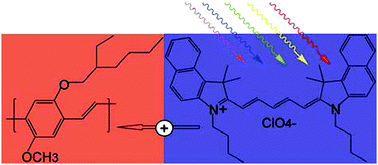Power-conversion efficiencies of organic heterojunction solar cells can be increased by using semiconducting donor–acceptor materials with complementary absorption spectra extending to the near-infrared region. Here, we used continuous wave fluorescence and absorption, as well as nanosecond transient absorption spectroscopy to study the initial charge transfer step for blends of a donor poly(p-phenylenevinylene) derivative and low-band gap cyanine dyes serving as electron acceptors. Electron transfer is the dominant relaxation process after photoexcitation of the donor. Hole transfer after cyanine photoexcitation occurs with an efficiency close to unity up to dye concentrations of ∼30 wt%. Cyanines present an efficient self-quenching mechanism of their fluorescence, and for higher dye loadings in the blend, or pure cyanine films, this process effectively reduces the hole transfer. Comparison between dye emission in an inert polystyrene matrix and the donor matrix allowed us to separate the influence of self-quenching and charge transfer mechanisms. Favorable photovoltaic bilayer performance, including high open-circuit voltages of ∼1 V confirmed the results from optical experiments. The characteristics of solar cells using different dyes also highlighted the need for balanced adjustment of the energy levels and their offsets at the heterojunction when using low-bandgap materials, and accentuated important effects of interface interactions and solid-state packing on charge generation and transport.

You have access to this article
 Please wait while we load your content...
Something went wrong. Try again?
Please wait while we load your content...
Something went wrong. Try again?


 Please wait while we load your content...
Please wait while we load your content...